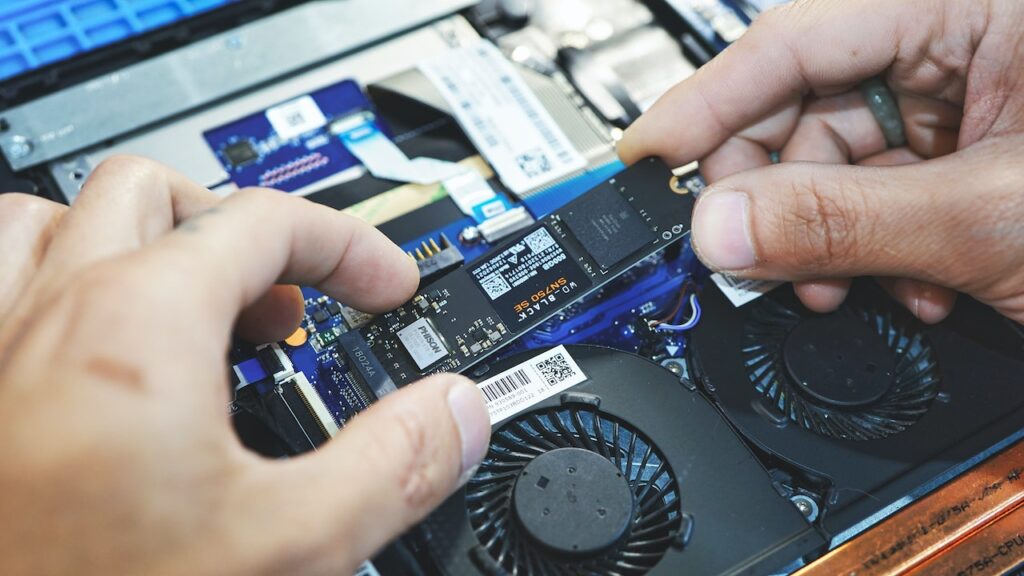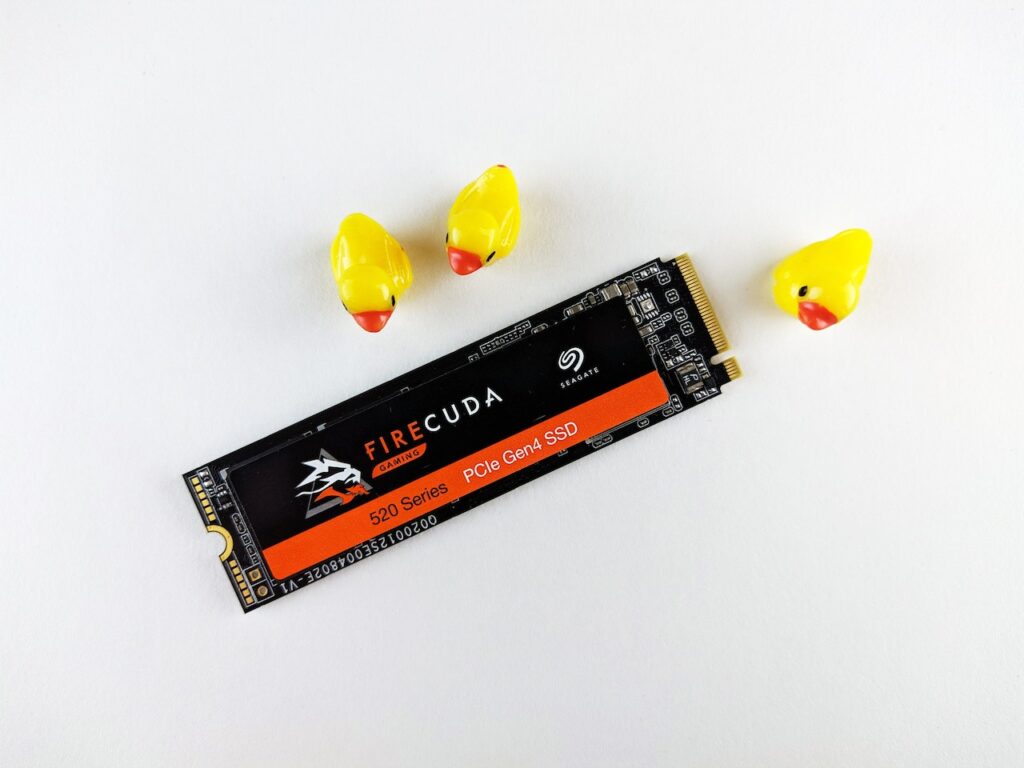The Importance of SSDs in Modern Computing
In the world of computing, storage is king. It can make or break the performance and efficiency of any system. For years, traditional hard drives dominated the market, offering large amounts of storage at a relatively low cost.
However, as technology advances and users demand faster and more responsive systems, solid-state drives (SSDs) are becoming the preferred choice for many. Especially if you just finished building your PC it is important to choose the right storage unite. An SSD is a type of storage device that uses flash memory to store data.
Unlike traditional hard drives, which use spinning disks to read and write data, SSDs have no moving parts, making them much faster and more reliable. They offer a number of benefits over traditional hard drives, including faster boot times, quicker application load times, reduced power consumption and increased durability.
M.2 SSDs: The Future of Storage
Among the various types of SSDs available on the market today is the M.2 SSD. This small form factor drive has become increasingly popular in recent years due to its compact size and lightning-fast speeds. M.2 SSDs are designed to be installed directly onto a motherboard using an M.2 slot – a small connector that allows for high-speed data transfer between your system’s drive and other components.
Unlike traditional SATA-based 2.5″ or 3.5″ SSDs which require cables for connectivity – thus taking up more space within your case – M.2 SSDs plug right into your motherboard saving you valuable space as well as increasing airflow within your PC case. Overall an M.2 offers unparalleled speed compared to any other type of storage solution offered at this time with achievable speeds greater than 3000 MB/s sequential read/write speeds thanks to advancements in NVMe tech (more on this later).
Why M.2 is Becoming More Popular?
Apart from the obvious reason of faster speed, another reason why M.2 SSDs are becoming increasingly popular is that they come in a variety of different form factors and sizes, making them highly versatile. M.2 drives also support the latest NVMe technology which further improves speeds over previous SATA-based SSDs.
Whether you’re looking to upgrade your existing system or build a new one from scratch, an M.2 SSD is an excellent choice for boosting performance and reducing load times across all applications on your computer – from operating system boot up to application load times and even game loading times. In the next sections of this article, we will explore the benefits of using an M.2 SSD in greater detail, how to choose the right one for your needs as well as provide instructions on how to install one onto your motherboard.
Benefits of using an M.2 SSD
Faster boot and load times compared to traditional hard drives
One of the most significant benefits of using an M.2 SSD is the speed at which it can boot up and load applications when compared to a traditional hard drive. Hard drives use mechanical disks that spin around and read data like a record player, while SSDs use flash memory that can be accessed instantly, which means no more waiting around for your computer to start up or for programs to open.
With an M.2 SSD, your operating system will boot up faster than ever before, with some systems taking just a few seconds from power on to login screen. Additionally, applications will open almost instantly, and you won’t have to wait for files to transfer or load.
Increased system responsiveness and overall performance
Upgrading your computer with an M.2 SSD can also greatly increase its overall responsiveness and performance. With faster read/write speeds, tasks such as opening large files or running multiple programs at once become much smoother.
Additionally, since the data on an SSD is not fragmented like it is on a traditional hard drive, there are no slowdowns due to disk fragmentation. Any program that relies on reading/writing data from/to disk will benefit from faster storage solutions.
Reduced power consumption and heat generation
Another benefit of using an M.2 SSD is its reduced power consumption when compared to traditional hard drives. Since there are no mechanical parts involved in reading/writing data on an SSD, it requires less power and generates less heat than a spinning hard drive. With the reduced amount of heat generated by your storage solution also comes the benefit of quieter operation since there are no moving parts in an SSD that can create noise.
More compact form factor, allowing for smaller and more efficient computer builds
M.2 SSDs are also much smaller in size when compared to traditional hard drives, allowing for more compact computer builds. This is especially beneficial for those who want to build a smaller form factor PC or laptop. The M.2 form factor is also more efficient since it eliminates the need for cables and mounting hardware that would typically be used for larger hard drives.
This not only allows for a cleaner system design but also makes maintenance and upgrades easier as there are fewer physical connections to deal with. Upgrading your computer with an M.2 SSD offers many benefits, including faster boot and load times, increased performance and responsiveness, reduced power consumption and heat generation, as well as a more compact form factor that allows for smaller and more efficient computer builds.
How to Choose the Right M.2 SSD for Your Needs
When it comes to choosing the right M.2 SSD, there are a few important factors to consider. First, you’ll need to decide whether you want an NVMe or SATA-based drive. NVMe drives are faster and more expensive, while SATA drives are slower and more affordable.
If you’re building a high-performance gaming PC or workstation, an NVMe drive is recommended due to its superior read and write speeds. However, if you’re on a budget or have more modest storage needs, a SATA-based M.2 SSD will still provide a significant performance boost over traditional hard drives.
Explanation of Different Types of M.2 SSDs (NVMe vs SATA)
NVMe stands for “Non-Volatile Memory Express” and is a new technology designed specifically for solid-state storage devices like M.2 SSDs. It uses fewer CPU cycles than traditional storage interfaces like AHCI (Advanced Host Controller Interface), allowing for much faster read and write speeds.
SATA-based M.2 SSDs, on the other hand, use the same interface as traditional hard drives but offer much faster performance due to their solid-state nature. Ultimately, your choice between NVMe and SATA will depend on your specific needs and budget.
Factors to Consider When Choosing an M.2 SSD (Capacity, Speed, Price)
The most important factor when choosing an M.2 SSD is capacity – that is, how much data it can hold – but speed and price are also important considerations. If you plan on storing large files such as videos or games on your drive, then you’ll want to go with a larger capacity model – at least 500GB or higher – while those with more modest storage needs can get by with smaller capacities. Speed is also an important consideration, as faster drives will provide better performance.
Look for models with high read and write speeds, especially if you plan on using your system for gaming or other demanding applications. Price is always a consideration when choosing any computer component.
M.2 SSDs are generally more expensive than traditional hard drives, but prices have been dropping in recent years as the technology becomes more widespread. Look for deals and sales to get the best possible price on your M.2 SSD.
How to Install an M.2 SSD

Installing an M.2 SSD onto a motherboard is a straightforward process, but it is important to follow the proper steps to ensure that the drive is installed and configured correctly.
Step-by-Step Guide for Installing an M.2 SSD
-
- First, locate the M.2 slot on your motherboard. This slot may be located on the front or back of the motherboard, so consult your motherboard manual if you are unsure.
-
- Gently insert the M.2 SSD into the slot at a slight angle, ensuring that it lines up with the keying notch and screw holes on both sides of the drive.
-
- Screw in the standoff screw near the center of where you inserted your drive; there should be one pre-installed for you. If not, then check your box for an extra screw and standoff.
-
- If necessary, attach any heatsinks or thermal pads included with your M.2 SSD to help dissipate heat generated by the drive during operation.
-
- Connect any cables required by your particular motherboard for this type of installation. For most motherboards, no additional cables are needed since they use PCIe lanes from CPU directly (check manual).
Configuring BIOS Settings for Optimal Performance
In order to take full advantage of your newly installed M.2 SSD, some changes may need to be made in your computer’s BIOS settings:
-
- Access your computer’s BIOS settings by pressing a specific key upon bootup (usually F10 or Delete) and navigate to “Advanced” or “Boot” section; consult manual if needed.
-
- Make sure the M.2 slot is enabled and that any SATA ports not being used are disabled to avoid confusion.
-
- Set the M.2 SSD as the primary boot device, ensuring that your computer boots from it instead of an older hard drive or SSD.
-
- This helps to achieve maximum performance, especially if you have installed your operating system on new drive.
-
- If you have installed an NVMe M.2 SSD, enable NVMe RAID in BIOS if available – this allows for higher speeds and more advanced RAID configurations (if desired).
-
- Note: This option is only available on certain motherboards with RAID support.
Closing Thoughts
Installing an M.2 SSD can greatly improve your computer’s speed and overall performance, but it is important to follow the proper steps for installation and configuration. By following the step-by-step guide outlined in this article and configuring your BIOS settings accordingly, you can make the most out of your new M.2 SSD and enjoy faster boot times, better responsiveness, and a smoother computing experience overall.
Conclusion
Recap of the benefits of using an M.2 SSD
Using an M.2 SSD has many benefits over traditional hard drives. The increased speed and responsiveness can significantly improve your computing experience, while the reduced power consumption and heat generation can lead to a more efficient system overall.
Additionally, the smaller form factor of M.2 SSDs allows for more compact and streamlined computer builds. One of the main advantages of using an M.2 SSD is the faster boot and load times compared to traditional hard drives.
This means that your computer will boot up quicker, programs will launch faster, and files will open with less delay. With an M.2 SSD in place, you’ll spend less time waiting for your computer to do what you need it to do.
Another benefit of using an M.2 SSD is increased system responsiveness and overall performance. The faster read/write speeds provided by these drives mean that your system can handle multiple tasks more efficiently, thus minimizing lag or slowdowns that might otherwise occur when running multiple applications simultaneously.
Encouragement for readers to consider upgrading their storage solution with an M.2 SSD
If you’re looking for a way to make your computer run faster and more efficiently, upgrading to an M.2 SSD is definitely worth considering! Whether you’re a gamer looking for snappier load times or a professional seeking enhanced productivity through improved system performance, this technology has a lot to offer.
While it may require a bit of research and some careful shopping around to find the right drive for your needs (and budget), taking the time to invest in an M.2 SSD can pay off in dividends when it comes to improving your computing experience overall. So don’t hesitate – start exploring what’s out there in terms of these speedy little devices today!

